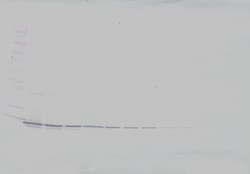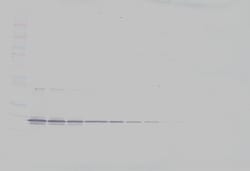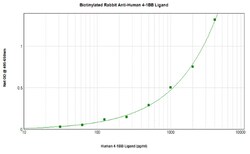Learn More
Invitrogen™ 4-1BB Ligand Polyclonal Antibody, Biotin, PeproTech®, Invitrogen™
Rabbit Polyclonal Antibody
Supplier: Invitrogen™ 500P169BT50UG

Description
AA Sequence of recombinant protein: MREGPELSPD DPAGLLDLRQ GMFAQLVAQN VLLIDGPLSW YSDPGLAGVS LTGGLSYKED TKELVVAKAG VYYVFFQLEL RRVVAGEGSG SVSLALHLQP LRSAAGAAAL ALTVDLPPAS SEARNSAFGF QGRLLHLSAG QRLGVHLHTE ARARHAWQLT QGATVLGLFR VTPEIPAGLP SPRSE. Preparation: Produced from sera of rabbits immunized with highly pure Recombinant Human 4-1BB Ligand. Anti-Human 4-1BB Ligand-specific antibody was purified by affinity chromatography and then biotinylated. Sandwich ELISA: To detect h4-1BBL by sandwich ELISA (using 100 μL/well antibody solution) a concentration of 0.25-1.0 μg/mL of this antibody is required. This biotinylated polyclonal antibody, in conjunction with PeproTech Polyclonal Anti-Human 4-1BBL (500-P169) as a capture antibody, allows the detection of at least 0.2-0.4 ng/well of Recombinant h4-1BBL. Western Blot: To detect h4-1BBL by Western Blot analysis this antibody can be used at a concentration of 0.1-0.2 μg/mL. Used in conjunction with compatible secondary reagents the detection limit for Recombinant h4-1BBL is 1.5-3.0 ng/lane, under either reducing or non-reducing conditions. 500-P169BT-1MG will be provided as 2 x 500 μg
CD137 ligand (CD137L) is a type II membrane protein and part of the TNF superfamily. CD137L is a co-stimulatory molecule that is expressed on antigen presenting cells (DCs, monocytes/macrophages, B cells) and is upregulated upon activation. Its receptor, CD137/4-1BB, is found on a variety of cells, including inflamed endothelial cells, where its expression enhances extravasation of CD137L expressing monocytes. Activated T cells also express CD137, and engagement with CD137L enhances T cell proliferation, IL-2 secretion, survival, and cytotoxic activity. CD137L is also expressed on a majority of B-cell lymphomas, including mantle cell lymphoma, follicular lymphoma, and diffuse large B-cell lymphoma (but it is lacking on Hodgkin lymphoma and T-cell lymphoma). CD137L is also expressed in carcinoma cell lines, and is thought to be involved in T cell-tumor cell interactions.
Specifications
| 4-1BB Ligand | |
| Polyclonal | |
| Biotin | |
| TNFSF9 | |
| 4 1 BB Ligand; 4 1 BBL; 41BB Ligand; 4-1BB ligand; 41BBL; 4-1BBL; 4-1BB-L; AI848817; CD 137 Ligand; CD 137L; CD137 Ligand; CD137L; Cd157l; CDw137L; costimulatory molecule; homolog of mouse 4-1BB-L; Ly63l; receptor 4-1BB ligand; TNFRSF9; Tnfsf9; TNLG5A; tumor necrosis factor (ligand) superfamily member 9; tumor necrosis factor (ligand) superfamily, member 9; tumor necrosis factor ligand 5A; tumor necrosis factor ligand superfamily member 9; tumor necrosis factor superfamily member 9 | |
| Rabbit | |
| Antigen Affinity Chromatography | |
| RUO | |
| 8744 | |
| -20°C | |
| Lyophilized |
| ELISA, Western Blot | |
| 0.1-1.0 mg/mL | |
| PBS with no preservative | |
| P41273 | |
| TNFSF9 | |
| E.coli-derived Recombinant Human 4-1BB Ligand. | |
| 50 μg | |
| Primary | |
| Human | |
| Antibody |
The Fisher Scientific Encompass Program offers items which are not part of our distribution portfolio. These products typically do not have pictures or detailed descriptions. However, we are committed to improving your shopping experience. Please use the form below to provide feedback related to the content on this product.


